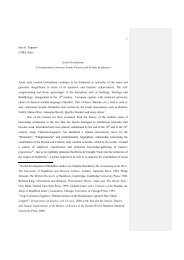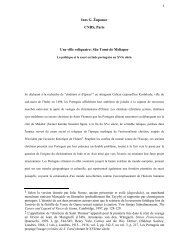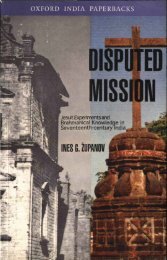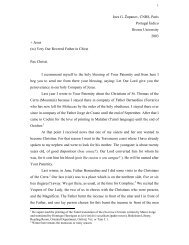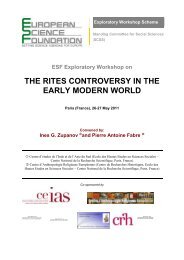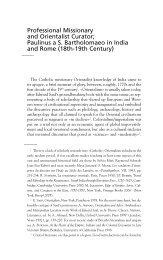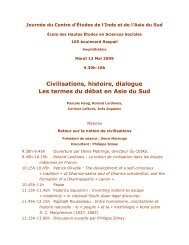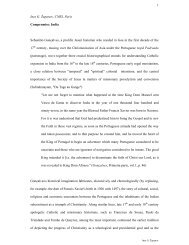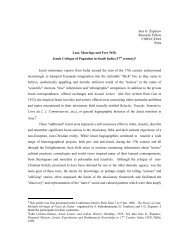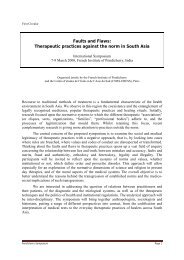Drugs, Health, Bodies and Souls in the Tropics ... - Ines G. Županov
Drugs, Health, Bodies and Souls in the Tropics ... - Ines G. Županov
Drugs, Health, Bodies and Souls in the Tropics ... - Ines G. Županov
Create successful ePaper yourself
Turn your PDF publications into a flip-book with our unique Google optimized e-Paper software.
27<br />
places <strong>in</strong> sou<strong>the</strong>rn India where Jesuits patiently carved <strong>and</strong> engraved <strong>the</strong> coord<strong>in</strong>ates<br />
of time <strong>and</strong> space aga<strong>in</strong>st what <strong>the</strong>y thought was <strong>the</strong> ever-encroach<strong>in</strong>g pagan chaos <strong>in</strong><br />
<strong>the</strong> background.<br />
<strong>Health</strong> as Order <strong>and</strong> Discipl<strong>in</strong>e<br />
Francis Xavier is reputed to have founded some forty or more churches on <strong>the</strong><br />
Fishery Coast, from Vembar <strong>in</strong> <strong>the</strong> north to Kanniyakumari on <strong>the</strong> sou<strong>the</strong>rnmost tip of<br />
<strong>the</strong> Indian pen<strong>in</strong>sula. 125 These were no more than palm-leaf provisional structures, but<br />
<strong>the</strong>y marked <strong>the</strong> po<strong>in</strong>t of special potentia, <strong>the</strong> <strong>in</strong>tersection of human <strong>and</strong> div<strong>in</strong>e, <strong>and</strong> a<br />
miraculous w<strong>in</strong>dow to an <strong>in</strong>visible presence of <strong>the</strong> supernatural. The churches <strong>and</strong> <strong>the</strong><br />
giant crosses <strong>in</strong> front of <strong>the</strong>m, made out of black varnished wood <strong>and</strong> lodged <strong>in</strong>to <strong>and</strong><br />
supported by white-washed stones, were not simply terrestrial antennas for catch<strong>in</strong>g<br />
div<strong>in</strong>e cosmic energy, <strong>the</strong>y were ra<strong>the</strong>r power plants of human relations <strong>and</strong> social<br />
articulation. Although dur<strong>in</strong>g his first stay among <strong>the</strong> Paravas, from 1542 to 1544,<br />
Xavier traveled <strong>in</strong>cessantly from one part of <strong>the</strong> coast to <strong>the</strong> o<strong>the</strong>r, without stay<strong>in</strong>g for<br />
a longer time <strong>in</strong> one place, <strong>the</strong> churches <strong>and</strong> chapels were left under <strong>the</strong> supervision of<br />
<strong>the</strong> prom<strong>in</strong>ent Parava catechists. These <strong>in</strong> were often recruited from or became <strong>the</strong><br />
chief overseas, pattankkatti, of Christian communities. The head overseers of <strong>the</strong><br />
Paravas, <strong>the</strong> patangat<strong>in</strong>-mór <strong>in</strong> Portuguese or jāti talaivar <strong>in</strong> Tamil, resided <strong>in</strong><br />
Tuticor<strong>in</strong> [Tūtūkkuti] <strong>and</strong> <strong>the</strong> hereditary holder of this office was later to become a<br />
Tamil "little k<strong>in</strong>g". 126 The new order imposed by Xavier <strong>and</strong> his successors, such as<br />
Henrique Henriques who arrived to this mission <strong>in</strong> 1547 <strong>and</strong> was buried <strong>in</strong> Tuticor<strong>in</strong><br />
<strong>in</strong> 1600, consisted <strong>in</strong> impos<strong>in</strong>g uniformity <strong>in</strong> ritual <strong>and</strong> cult observances, especially<br />
geared at confession <strong>and</strong> <strong>the</strong> sacrament of penance, <strong>and</strong> <strong>in</strong> empower<strong>in</strong>g <strong>the</strong> traditional<br />
caste notables as executive officials subject to <strong>the</strong> "spiritual" guidance of <strong>the</strong><br />
missionaries. Through <strong>in</strong>ner <strong>and</strong> outer regeneration, Jesuit priestly sponsorship <strong>the</strong>n<br />
ultimately enhanced <strong>the</strong> Parava sense of separate identity <strong>and</strong> caste solidarity.<br />
The success of <strong>the</strong> mission among <strong>the</strong> Paravas was not simply a triumph of<br />
Jesuit social eng<strong>in</strong>eer<strong>in</strong>g, but also <strong>the</strong> result of a comb<strong>in</strong>ation of geographical, social<br />
<strong>and</strong> political factors. 127 In different contexts, say <strong>in</strong> Japan, <strong>in</strong> <strong>the</strong> mission at <strong>the</strong><br />
Mughal court or <strong>in</strong> Monomotapa, <strong>the</strong> cont<strong>in</strong>gencies of local politics brought <strong>the</strong><br />
situation out of control. In spite of <strong>the</strong> <strong>in</strong>evitable setbacks, however, <strong>the</strong> Jesuits were<br />
still <strong>the</strong> most <strong>in</strong>fluential missionary order, because unlike o<strong>the</strong>r zealous missionaries<br />
<strong>in</strong> <strong>the</strong> sixteenth century, Franciscans <strong>and</strong> Dom<strong>in</strong>icans <strong>and</strong> o<strong>the</strong>r ecclesiastical figures,<br />
<strong>the</strong>y not only had <strong>the</strong> general plan, but also <strong>the</strong> method. In fact, this method was a<br />
work <strong>in</strong> progress chiseled out <strong>and</strong> tested through experience. In <strong>the</strong>ir gigantic<br />
correspondence from all over <strong>the</strong> world to Rome <strong>and</strong> vice versa, made m<strong>and</strong>atory by<br />
<strong>the</strong> Society of Jesus, <strong>the</strong> Jesuits created a forum for exchang<strong>in</strong>g ideas, compar<strong>in</strong>g<br />
notes <strong>and</strong> tak<strong>in</strong>g concerted decisions on a scale that had not been seen before.<br />
Accord<strong>in</strong>g to <strong>the</strong> Formula of <strong>the</strong> Institute of <strong>the</strong> Society of Jesus, <strong>the</strong> first<br />
program among <strong>the</strong> Jesuit m<strong>in</strong>istries was: m<strong>in</strong>istries of <strong>the</strong> Word, of <strong>the</strong> sacraments<br />
125 Epistolae Mixtae ex variis Europae locis ab anno 1537 ad 1566 scriptae. Matriti, 1898, vol. 1, p.<br />
231. Schurhammer, Georg, S.J., Francis Xavier; His Life, His Times, vol. 2, India, (1541-1545),<br />
(Freiburg am Breisgau, 1963) transl. M. J. Costelloe, Rome, 1977 India, p. 341.<br />
126 On <strong>the</strong> concept of little k<strong>in</strong>g <strong>in</strong> Tamilnadu see Dirks, Nicholas, B., The Hollow Crown; Ethnohistory<br />
of an Indian K<strong>in</strong>gdom, Ann Arbor, 1993. See also a very <strong>in</strong>formative article by Ā.Sivasuppiramaïiyaú,<br />
Paratar kalveììuc ceytikal (Parava Inscriptions), (xerox copy, no publisher, no date).<br />
127 <strong>Županov</strong>, <strong>Ines</strong> G., "Prosélytisme et pluralisme religieux: deux expériences miss<strong>in</strong>naires en Inde aux<br />
XVIe et XVIIe siecles", Archives de Sciences Sociales des Religions, 87, 1994, pp. 35-56..<br />
<strong>Ines</strong> G. <strong>Županov</strong>, CNRS, Paris




